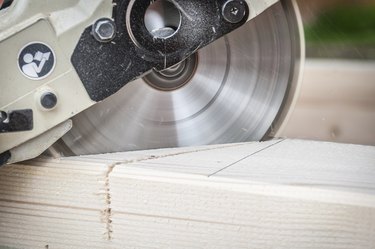
Wood cuts refers to the way and resulting size of a log when it is cut into lumber. Three main types of cuts abound in the lumber market: plain sawn, quarter sawn and rift sawn. Different wood working projects sometimes require a specific size or cut of lumber. Larger wood cuts generally cost less overall than smaller cuts but require more time to cut down and refine for smaller projects.
Plain Sawn
Video of the Day
Plain sawn lumber results from cutting a log in half lengthwise and then making all other cuts parallel to the first. Plain sawing is the least expensive type of wood cut because it results in the largest boards with very little waste. It is the most common form of wood cut, and most wood flooring is plain sawn. Plain sawn lumber produces the most variation within the boards and among a group of boards. The main disadvantage to plain sawn wood cuts is less dimensional stability, which means more expansion and contraction of the width of the board. Plain sawn wood cuts result in more noticeable wood grain patterns from the annual rings of a tree. When imperfections in the wood present themselves, plain sawing limits them to fewer boards than other types of wood cuts.
Video of the Day
Quarter Sawn Cut
Quarter sawn cuts produce a long, straight grain pattern. Quarter sawn lumber is produced by first cutting a log into quarters and then cutting each additional piece perpendicular to the annual growth rings of the log. Quarter sawn lumber has more strength than plain sawn wood because of the tight grain pattern produced by cutting against the growth rings. It is used in wood flooring for its grain pattern and strength, and is generally more expensive than plain sawn cuts of wood. Quarter sawn wood expands vertically instead of horizontally, and generally twists and cups less because of its smaller surface area. The quarter sawn cut produces smaller pieces than the plain sawn cut, which makes them ideal for smaller projects, or projects that require strength and vertical expansion. This cut generally wears more evenly when used for flooring and splits less during construction. It also makes the prominent raised grain of the tree's annual growth rings less noticeable.
Rift Sawn Cut
Rift sawn lumber is similar to quarter sawn lumber except that the cut is made at a 30-degree angle instead of a 25-degree angle. Rift sawn lumber has many of the same benefits and disadvantages as quarter sawn lumber, with the notable difference being that rift sawn cuts lessen the flake effect, or horizontal medullary rays of the tree that are visible within the vertical grain of the wood. Rift sawing produces an almost straight vertical grain pattern. Like quarter sawn lumber, rift cuts are stronger and smaller than plain sawn lumber.